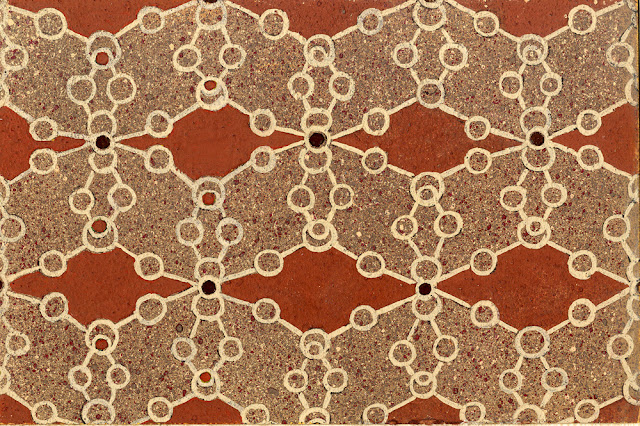For background information on the Festival of Britain (1951) see part 1 of this post. Part 2 takes a look at the unusual and innovative approach the Festival designers took with regard to contemporary textiles.  |
| � James Templeton & Co |
Twenty-eight leading manufacturers took part in the Festival of Britain's Festival Pattern Group, which used diagrams of atomic structure to provide design inspiration; a unique project involving X-ray crystallographers, designers and manufacturers. 80 designs were produced in all, including glass, ceramics, metal, plastics, textiles and wallpaper.  |
| � James Templeton & Co |
By studying X-ray diffraction photographs of crystals, scientists could calculate the arrangement of atoms within molecules. The resulting diagrams provided the inspiration for the Festival Pattern Group, highlighting the intricacy and beauty of crystal structures. These avante-garde designs stand as a testament to the optimism of the early post-war era and the vibrancy of 1950s design. |
| 'Copper Aluminium Alloy' � James Templeton & Co |
Tie Fabrics. Sample booklets containing tie fabrics were also on display at the Festival of Britain. All were made of jacquard-woven silk and designed by George Reynolds for Vanners and Fennel, a specialist in fabric for ties and cravats. The company entered spiritedly into the Festival Pattern Group, creating seven crystal structure designs. From a commercial point of view, Vanners and Fennell's jacquard-woven silk ties were one of the successful products in the Festival Pattern Group. One of the few companies still in operation today, Vanners (as they are now known) continue to specialise in jacquard-woven tie silks. |
| Tie fabrics designed by George Reynolds for Vanners and Fennel � V&A |
Nylon 8.54c wallpaper ('Cherwell'). Although not used at the Festival of Britain, this screen-printed wallpaper features the crystal structure of nylon and was created as part of the Festival Pattern Group. This piece is from the manufacturer's sample book, hence the annotations. The fact that it was given a pattern name - 'Cherwell' - indicates that it was intended for production.
 |
| 'Nylon 8.54c wallpaper (Cherwell)' Crystallographer, Charles William Bunn. Designed by William Odell for John Line and Sons � John Line and Sons |
Boric Acid 8.34 Wallpaper. This screen-printed wallpaper was designed by William Odell for John Line and Sons.
 |
| Boric Acid 8.34 Wallpaper � John Line and Sons |
Insulin 8.25 Wallpaper. Crystallographer: Dorothy Hodgkin; designed by Robert Sevant for John Line and Sons. Dorothy Hodgkin's diagram, on which this screen-printed wallpaper is based, was originally published in an article in 'Proceedings of the Royal Society' in 1938. The designer has simplified the pattern by extracting the hexagonal motifs and omitting the rounded triangular forms. This wallpaper was used in the Cinema Foyer at the Exhibition of Science in 1951 and has been re-created for this exhibition.
 |
Insulin 8.25 Wallpaper � John Line and Sons
|
 |
| Insulin 8.25 Wallpaper � John Line and Sons � V&A |
|
|
|
|
|
Apophyllite 8.30 Lace. This machine-embroidered cotton lace was manufactured by A. C. Gill.



































Tidak ada komentar :
Posting Komentar